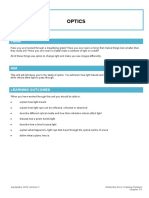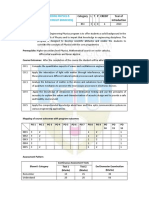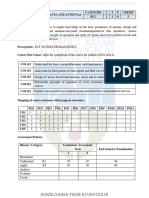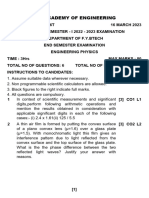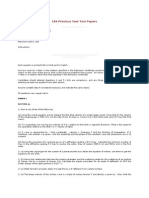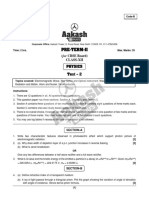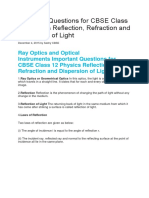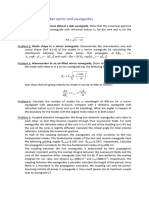Engineering Physics A
Engineering Physics A
Uploaded by
amelbiju2004Copyright:
Available Formats
Engineering Physics A
Engineering Physics A
Uploaded by
amelbiju2004Original Title
Copyright
Available Formats
Share this document
Did you find this document useful?
Is this content inappropriate?
Copyright:
Available Formats
Engineering Physics A
Engineering Physics A
Uploaded by
amelbiju2004Copyright:
Available Formats
PHT ENGINEERING PHYSICS A CATEGORY L T P CREDIT YEAR OF
100 (FOR CIRCUIT BRANCHES) INTRODUCTION
BSC 3 1 0 4 2019
Preamble: The aim of the Engineering Physics Program is to offer students a solid background in the
fundamentals of Physics and to impart that knowledge in engineering disciplines. The
program is designed to develop scientific attitudes and enable the students to correlate
the concepts of Physics with the core programmes
Prerequisite: Higher secondary level Physics, Mathematical course on vector calculus,
differential equations and linear algebra
Course Outcomes: After the completion of the course the student will be able to
CO 1 Compute the quantitative aspects of waves and oscillations in engineering systems.
CO 2 Apply the interaction of light with matter through interference, diffraction and identify
these phenomena in different natural optical processes and optical instruments.
CO 3 Analyze the behaviour of matter in the atomic and subatomic level through the principles of
quantum mechanics to perceive the microscopic processes in electronic devices.
CO 4 Classify the properties of magnetic materials and apply vector calculus to static magnetic
fields and use Maxwell’s equations to diverse engineering problems
CO 5 Analyze the principles behind various superconducting applications, explain the working of
solid state lighting devices and fibre optic communication system
Mapping of course outcomes with program outcomes
PO 1 PO 2 PO 3 PO 4 PO 5 PO 6 PO 7 PO 8 PO 9 PO 10 PO 11 PO 12
CO 1 3 2 1 2 1
CO 2 3 2 1 2 1
CO 3 3 2 1 2 1
CO 4 3 1 1 2 1
CO 5 3 1 1 2 1
Assessment Pattern
Continuous Assessment Tests
Bloom’s Category Test 1 Test 2 End Semester Examination
(Marks) (Marks) (Marks)
Remember 15 15 30
Understand 25 25 50
Apply 10 10 20
Downloaded from Ktunotes.in
Analyse
Evaluate
Create
Mark distribution
Total Marks CIE ESE ESE Duration
marks marks
150 50 100 3 hours
Continuous Internal Evaluation Pattern:
Attendance : 10 marks
Continuous Assessment Test (2 numbers) : 25 marks
Assignment/Quiz/Course project : 15 marks
End Semester Examination Pattern: There will be two parts; Part A and Part B. Part A contain 10
questions with 2 questions from each module, having 3 marks for each question. Students should
answer all questions. Part B contains 2 questions from each module of which student should answer
any one. Each question can have maximum 2 sub-divisions and carry 14 marks.
Course Level Assessment Questions
Course Outcome 1 (CO1):
1. Explain the effect of damping force on oscillators.
2. Distinguish between transverse and longitudinal waves.
3. (a) Derive an expression for the fundamental frequency of transverse vibration in a
stretched string.
(b) Calculate the fundamental frequency of a string of length 2 m weighing 6 g kept
stretched by a load of 600 kg.
Course Outcome 2 (CO2):
1. Explain colours in thin films.
2. Distinguish between Fresnel and Fraunhofer diffraction.
3. (a) Explain the formation of Newton’s rings and obtain the expression for radii of bright and
dark rings in reflected system. Also explain how it is used to determine the wavelength of
a monochromatic source of light.
(b) A liquid of refractive index µ is introduced between the lens and glass plate.
Downloaded from Ktunotes.in
What happens to the fringe system? Justify your answer.
Course Outcome 3 (CO3):
1. Give the physical significance of wave function ?
2. What are excitons ?
3. (a) Solve Schrodinger equation for a particle in a one dimensional box and obtain its
energy eigen values and normalised wave functions.
(b) Calculate the first three energy values of an electron in a one dimensional box of width
1 A0 in electron volt.
Course Outcome 4 (CO4):
1. Compare displacement current and conduction current.
2. Mention any four properties of ferro magnetic materials.
3. (a) Starting from Maxwell’s equations, derive the free space electromagnetic wave
equation and show that velocity of electromagnetic wave is 1/ (µo εo) ½
(b) An electromagnetic wave is described by E = 100 exp 8πi [10 14 t – (10 6 z / 3)] V/m.
Find the direction of propagation of the wave,speed of the wave and magnetic flux
density in the wave.
Course Outcome 5 (CO5):
1. Explain the working of a solar cell.
2. Distinguish between Type I and Type II super conductors.
3. (a) Define numerical aperture and derive an expression for it.
(b) Explain the working of intensity modulated fibre optic sensor.
Downloaded from Ktunotes.in
Model Question paper
QP CODE: PAGES:3
Reg No:______________
Name :______________
APJ ABDUL KALAM TECHNOLOGICAL UNIVERSITY FIRST SEMESTER B.TECH DEGREE EXAMINATION,
MONTH & YEAR
Course Code: PHT 100
Course Name: Engineering Physics A
Max. Marks: 100 Duration: 3 Hours
PART A
Answer all Questions. Each question carries 3 Marks
1. Compare electrical and mechanical oscillators
2. Distinguish between longitudinal and transverse waves
3. Write a short note on antireflection coating.
4. Diffraction of light is not as evident in daily experience as that of sound waves. Give reason.
5. State and explain Heisenberg’s Uncertainty principle. With the help of it explain natural
line broadening.
6. Explain surface to volume ratio of nanomaterials.
7. State Faraday’s laws of electromagnetic induction.
8. Compare displacement current and conduction current
9. List four important applications of superconductors.
10. Give the working principle of LED. (10x3=30)
PART B
Answer any one full question from each module. Each question carries 14 Marks
Module 1
Downloaded from Ktunotes.in
11. (a) Derive the differential equation of damped harmonic oscillator and deduce its
solution.Discuss the cases of over damped, critically damped and under damped cases. (10)
(b) The frequency of a tuning fork is 500 Hz and its Q factor is 7×10 4. Find the relaxation time.
Also calculate the time after which its energy becomes 1/10 of its initial undamped value.(4)
12. (a) Derive an expression for the velocity of propagation of a transverse wave in a stretched
string. Deduce laws of transverse vibrations. (10)
(b) The equation of transverse vibration of a stretched string is given by y =0.00327 sin (72.1x-
2.72t)m, in which the numerical constants are in S.I units. Evaluate (i) Amplitude (ii) Wavelength
(iii) Frequency and (iv)Velocity of the wave. (4)
Module 2
13.(a)Explain the formation of Newton’s rings and show that the radius of dark ring is
proportional to the square root of natural numbers. How can we use Newton’s rings
experiment to determine the refractive index of a liquid. (10)
(b) Two pieces of plane glass are placed together with a piece of paper between two at one
end. Find the angle of the wedge in seconds if the film is viewed with a monochromatic light of
wavelength 4800Å. Given β = 0.0555 cm. (4)
14. (a) Explain the diffraction due to a plane transmission grating. Obtain the grating equation. (10)
(b) A grating has 6000 lines per cm. Find the angular separation of the two yellow lines
of mercury of wavelengths 577 nm and 579 nm in the second order. (4)
Module 3
15.(a) Derive time dependent and independent Schrodinger equations. (10)
(b) An electron is confined to one dimensional potential box of length 2Å. Calculate the energies
corresponding to the first and second quantum states in eV. (4)
16.(a) Classify nanomaterials based on dimensionality of quantum confinement and explain the
following nanostructures. (i) nano sheets (ii) nano wires (iii) quantum dots. (10)
(b) Find the de Broglie wavelength of electron whose kinetic energy is 15 eV. (4)
Module 4
17.(a) State Poynting’s Theorem. Calculate the value of Poynting vector at the surface of the sun if
the power radiated by the sun is 3.8 x 10 26 W and its radius is 7 X 10 8 m. (5)
Downloaded from Ktunotes.in
(b) Distinguish between paramagnetic, diamagnetic and ferromagnetic materials. (9)
18.(a) Starting from Maxwell’s Equations, derive electromagnetic wave equations in free space. (10)
(b) If the magnitude of H in a plane wave is 1 A/m, find the magnitude of E in free space. (4)
Module 5
19.(a) Show that superconductors are perfect diamagnets. Distinguish between Type I and
Type II superconductors with suitable examples. (10)
(b) Write a short note on high temperature superconductors. (4)
20.(a) Define numerical aperture of an optic fibre and derive an expression for the NA of a step
index fibre with a neat diagram. (10)
(b) Calculate the numerical aperture and acceptance angle of a fibre with a core refractive index
of 1.54 and a cladding refractive index of 1.50 when the fibre is inside water of refractive
index 1.33. (4) (14x5=70)
Downloaded from Ktunotes.in
Syllabus
ENGINEERING PHYSICS A
(FOR CIRCUIT BRANCHES)
Module 1
Oscillations and Waves
Harmonic oscillations, Damped harmonic motion-Derivation of differential equation and its solution,
Over damped, Critically damped and Under damped Cases, Quality factor-Expression, Forced
oscillations-Differential Equation-Derivation of expressions for amplitude and phase of forced
oscillations, Amplitude Resonance-Expression for Resonant frequency, Quality factor and Sharpness
of Resonance, Electrical analogy of mechanical oscillators
Wave motion- Derivation of one dimensional wave equation and its solution, Three dimensional
wave equation and its solution (no derivation), Distinction between transverse and longitudinal
waves, Transverse vibration in a stretched string, Statement of laws of vibration
Module 2
Wave Optics
Interference of light-Principle of superposition of waves, Theory of thin films - Cosine law (Reflected
system), Derivation of the conditions of constructive and destructive Interference, Interference due
to wedge shaped films -Determination of thickness and test for optical planeness, Newton’s rings -
Measurement of wavelength and refractive index, Antireflection coatings
Diffraction of light, Fresnel and Fraunhofer classes of diffraction, Diffraction grating-Grating
equation, Rayleigh criterion for limit of resolution, Resolving and Dispersive power of a grating with
expression (no derivation)
Module 3
Quantum Mechanics & Nanotechnology
Introduction for the need of Quantum mechanics, Wave nature of Particles, Uncertainty principle,
Applications-Absence of electrons inside a nucleus and Natural line broadening mechanism,
Formulation of time dependent and independent Schrodinger wave equations-Physical meaning of
wave function, Particle in a one dimensional box- Derivation for normalised wave function and
energy eigen values, Quantum Mechanical Tunnelling (Qualitative)
Introduction to nanoscience and technology, Increase in surface to volume ratio for nanomaterials,
Quantum confinement in one dimension, two dimension and three dimension-Nano sheets, Nano
wires and Quantum dots, Properties of nanomaterials-mechanical, electrical and optical,
Applications of nanotechnology (qualitative ideas)
Module 4
Magnetism & Electro Magnetic Theory
Magnetic field and Magnetic flux density, Gauss’s law for Magnetic flux density, Ampere’s Circuital
law, Faraday’s law in terms of EMF produced by changing magnetic flux, Magnetic permeability and
susceptibility, Classification of magnetic materials-para, dia and ferromagnetic materials
Downloaded from Ktunotes.in
Fundamentals of vector calculus, concept of divergence, gradient and curl along with physical
significance, Line, Surface and Volume integrals, Gauss divergence theorem & Stokes’ theorem,
Equation of continuity, Derivation of Maxwell’s equations in vacuum, Comparison of displacement
current with conduction current. Electromagnetic waves, Velocity of Electromagnetic waves in free
space, Flow of energy and Poynting’s vector (no derivation)
Module 5
Superconductivity & Photonics
Superconducting phenomena, Meissner effect and perfect diamagnetism, Types of superconductors-
Type I and Type II, BCS Theory (Qualitative), High temperature superconductors-Applications of
super conductivity
Introduction to photonics-Photonic devices-Light Emitting Diode, Photo detectors -Junction and PIN
photodiodes, Solar cells-I-V Characteristics, Optic fibre-Principle of propagation of light, Types of
fibres-Step index and Graded index fibres, Numerical aperture –Derivation, Fibre optic
communication system (block diagram), Industrial, Medical and Technological applications of optical
fibre, Fibre optic sensors-Intensity Modulated and Phase modulated sensors.
Text Books
1. M.N.Avadhanulu, P.G.Kshirsagar,TVS Arun Murthy “A Text book of Engineering Physics”, S.Chand
&Co., Revised Edition 2019
2. H.K.Malik , A.K. Singh, “Engineering Physics” McGraw Hill Education, Second Edition 2017
Reference Books
1. Arthur Beiser, “Concepts of Modern Physics ", Tata McGraw Hill Publications, 6th Edition
2003
2. D.K. Bhattacharya, Poonam Tandon, “Engineering Physics”, Oxford University Press, 2015
3. Md.N.Khan & S.Panigrahi “Principles of Engineering Physics 1&2”, Cambridge University
Press, 2016
4. Aruldhas G., “Engineering Physics”, PHI Pvt. Ltd., 2015
5. Ajoy Ghatak, “Optics”, Mc Graw Hill Education, Sixth Edition, 2017
6. T. Pradeep, “Nano:The Essentials’’, McGraw Hill India Ltd, 2007
7. Halliday, Resnick, Walker, “Fundamentals of Physics’’, John Wiley & Sons.Inc, 2001
8. David J Griffiths, “Introduction to Electrodynamics’’, Addison-Wesley publishing, 3rd Edition,
1999
9. Premlet B., “Advanced Engineering Physics”, Phasor Books,10th edition,2017
10. I. Dominic and. A. Nahari, “A Text Book of Engineering physics”, Owl Books Publishers,
Revised edition, 2016
Downloaded from Ktunotes.in
Course Contents and Lecture Schedule
No Topic No. of Lectures
1 Oscillations and Waves (9 hours)
1.1 Harmonic oscillations, Damped harmonic motion-Derivation of 2 hrs
differential equation and its solution, Over damped, Critically damped
and Under damped Cases, Quality factor-Expression
1.2 Forced oscillations-Differential Equation-Derivation of expressions for
amplitude and phase of forced oscillations, Amplitude Resonance- 3hrs
Expression for Resonant frequency, Quality factor and Sharpness of
Resonance, Electrical analogy of mechanical oscillators
1.3 Wave motion- Derivation of one dimensional wave equation and its
solution, Three dimensional wave equation and its solution (no
derivation) 2 hrs
1.4 Distinction between transverse and longitudinal waves. Transverse 2 hrs
vibration in a stretched string, Statement of laws of vibration
2 Wave Optics (9 hours)
2.1 Interference of light-Principle of superposition of waves, Theory of thin 2 hrs
films - Cosine law (Reflected system), Derivation of the conditions of
constructive and destructive Interference
2.2 Interference due to wedge shaped films -Determination of thickness 4 hr
and test for optical planeness, Newton’s rings - Measurement of
wavelength and refractive index, Antireflection coatings
2.3 Diffraction of light, Fresnel and Fraunhofer classes of diffraction, 2 hrs
Diffraction grating-Grating equation
2.4 Rayleigh criterion for limit of resolution, Resolving and Dispersive 1 hr
power of a grating with expression (no derivation)
3 Quantum Mechanics &Nanotechnology (9hours)
3.1 Introduction for the need of Quantum mechanics, Wave nature of 2 hrs
Particles, Uncertainty principle, Applications-Absence of electrons
inside a nucleus and Natural line broadening mechanism
3.2 Formulation of time dependent and independent Schrodinger wave 4 hrs
equations-Physical Meaning of wave function, Particle in a one
dimensional box- Derivation for normalised wave function and energy
eigen values, Quantum Mechanical Tunnelling (Qualitative)
3.3 Introduction to nanoscience and technology, Increase in surface to 2 hrs
volume ratio for nanomaterials, Quantum confinement in one
dimension, two dimension and three dimension-Nano sheets, Nano
wires and Quantum dots
3.4 Properties of nanomaterials-mechanical, electrical and optical 1 hr
Applications of nanotechnology (qualitative ideas)
4 Magnetism & Electro Magnetic Theory (9 hours)
4.1 Magnetic field and Magnetic flux density, Gauss’s law for Magnetic flux 2 hrs
Downloaded from Ktunotes.in
density, Ampere’s Circuital law, Faraday’s law in terms of EMF
produced by changing magnetic flux
4.2 Explanation for Magnetic permeability and susceptibility Classification 1 hr
of magnetic materials- para, dia and ferromagnetic materials
4.3 Fundamentals of vector calculus, concept of divergence, gradient and 2 hrs
curl along with physical significance, Line, Surface and Volume integrals,
Gauss divergence theorem & Stokes’ theorem
4.4 Equation of continuity, Derivation of Maxwell’s equations in vacuum, 4 hrs
Comparison of displacement current with conduction current.
Electromagnetic waves, Velocity of Electromagnetic waves in free
space, Flow of energy and Poynting’s vector (no derivation)
5 Superconductivity &Photonics (9hours)
5.1 Super conducting Phenomena, Meissner effect and perfect 2 hrs
diamagnetism, Types of superconductors-Type I and Type II
5.2 BCS Theory (Qualitative), High temperature superconductors, 2 hrs
Applications of super conductivity
5.3 Introduction to photonics-Photonic devices-Light Emitting Diode, Photo 2 hrs
detectors -Junction and PIN photodiodes, Solar cells-I-V Characteristics
5.4 Optic fibre-Principle of propagation of light, Types of fibres-Step index 3 hrs
and Graded index fibres, Numerical aperture –Derivation, Fibre optic
communication system (block diagram), Industrial, Medical and
Technological applications of optical fibre, Fibre optic sensors-Intensity
Modulated and Phase modulated sensors
Downloaded from Ktunotes.in
You might also like
- OpticsDocument16 pagesOpticsJúnior AlvesNo ratings yet
- Engineering Physics ADocument10 pagesEngineering Physics AAdarsh QclwNo ratings yet
- Engineering Physics B (For Non-Circuit Branches) : Category L T P Credit Year ofDocument10 pagesEngineering Physics B (For Non-Circuit Branches) : Category L T P Credit Year ofBalagopal VNo ratings yet
- EET204 - ktu qbankDocument8 pagesEET204 - ktu qbankSanal KrishnaNo ratings yet
- Electromagnetic TheoryDocument8 pagesElectromagnetic TheoryAlakaaa PromodNo ratings yet
- Engineering Chemistry 2019 Scheme SyllabusDocument9 pagesEngineering Chemistry 2019 Scheme SyllabusAfsal Sha MNo ratings yet
- Engineering PhysicsDocument9 pagesEngineering PhysicsPrashant RajNo ratings yet
- Microwaves and AntennasDocument7 pagesMicrowaves and Antennaspaperprep3No ratings yet
- Btech 2 Sem Engineering Physics Kas201t 2022Document2 pagesBtech 2 Sem Engineering Physics Kas201t 2022Neelam SinghNo ratings yet
- EC2019s7s8 SyllabusDocument331 pagesEC2019s7s8 SyllabusShanu NNo ratings yet
- Basics of Electrical and Electronics EngineeringDocument55 pagesBasics of Electrical and Electronics EngineeringMeera GeneshNo ratings yet
- Basics of Electrical and ElectronicsDocument11 pagesBasics of Electrical and ElectronicsannpotterNo ratings yet
- Institute of Aeronautical EngineeringDocument5 pagesInstitute of Aeronautical EngineeringAshok BhatiaNo ratings yet
- Assignment Booklet: Elements of Modern PhysicsDocument4 pagesAssignment Booklet: Elements of Modern PhysicsQwertyuNo ratings yet
- 4th Sem Question Bank FinalDocument20 pages4th Sem Question Bank Finalanimasantra351No ratings yet
- 12th Physics 2nd Half Syllabus Test 19-NovDocument6 pages12th Physics 2nd Half Syllabus Test 19-NovSaurabhNo ratings yet
- Btech 1 Sem Physics Kas101 2022Document2 pagesBtech 1 Sem Physics Kas101 2022Neelam SinghNo ratings yet
- Engineering ChemistryDocument9 pagesEngineering ChemistryAnuj EsthapanoseNo ratings yet
- 107 B.tech Engg - PhysicsDocument5 pages107 B.tech Engg - Physicsrhq4w5hgm7No ratings yet
- CBSE Sample Paper Class 12 Physics Set 9: Section - ADocument4 pagesCBSE Sample Paper Class 12 Physics Set 9: Section - AI dont have a NameNo ratings yet
- EN09 103 EnggDocument2 pagesEN09 103 EnggRanjith SomanNo ratings yet
- Scan 22 Feb 2022Document3 pagesScan 22 Feb 2022Aditya KavalanekarNo ratings yet
- Question Bank IA I (AP 2024 25)Document2 pagesQuestion Bank IA I (AP 2024 25)anushkamohite98No ratings yet
- UGPHS-C9 (1)Document4 pagesUGPHS-C9 (1)Physics RamnagarNo ratings yet
- Tma, BPHCT-137 E, 2024 (03.01.2024)Document4 pagesTma, BPHCT-137 E, 2024 (03.01.2024)raulsohan1234No ratings yet
- KAS201Document2 pagesKAS201DR ABHISHEK TIWARINo ratings yet
- 2023 JuneDocument3 pages2023 Juneadithyan sreeniNo ratings yet
- Syllabus - Electromagnetics LabDocument3 pagesSyllabus - Electromagnetics LabShakiraNo ratings yet
- Au Coe QP: Question Paper Code: PHDocument2 pagesAu Coe QP: Question Paper Code: PHajithNo ratings yet
- ATOMIC STRUCTURE Work Sheet For IIT RevisionDocument8 pagesATOMIC STRUCTURE Work Sheet For IIT RevisionSai SreyanNo ratings yet
- (Three Hours) : Sample Paper - 2011 Class - XII Subject - PhysicsDocument5 pages(Three Hours) : Sample Paper - 2011 Class - XII Subject - PhysicsValay DaveNo ratings yet
- Assignment 1- CSEDocument2 pagesAssignment 1- CSErajpriyanshi001No ratings yet
- Image MarkedDocument1 pageImage MarkedVarunNo ratings yet
- Semester - 3: Chemical EngineeringDocument135 pagesSemester - 3: Chemical EngineeringKevinNo ratings yet
- CHE-01 Assignment 2021 (English)Document4 pagesCHE-01 Assignment 2021 (English)pranay mondalNo ratings yet
- IAT-III Question Paper with Solution of 21PHY12 Engineering Physics March-2022-Dr. Raveesha K HDocument8 pagesIAT-III Question Paper with Solution of 21PHY12 Engineering Physics March-2022-Dr. Raveesha K HSiddannaNo ratings yet
- ALL QB's PDFDocument36 pagesALL QB's PDFanimesh0gargNo ratings yet
- FY BTech - AS - Engineering Physics - SEM-I - Mar 2023Document3 pagesFY BTech - AS - Engineering Physics - SEM-I - Mar 2023kumbhalkarvalay8No ratings yet
- CBSE Sample Paper Class 12 Physics Set 3: All Questions Are Compulsory. There Are 27 Questions in AllDocument4 pagesCBSE Sample Paper Class 12 Physics Set 3: All Questions Are Compulsory. There Are 27 Questions in AllI dont have a NameNo ratings yet
- QP CODE: 23104206: Reg No: NameDocument2 pagesQP CODE: 23104206: Reg No: NameAthul LXNo ratings yet
- Syllabus - S6Document85 pagesSyllabus - S6B 15 Aravinth VKNo ratings yet
- Engineering Physics Question BankDocument7 pagesEngineering Physics Question BankbharatpchandranNo ratings yet
- Nanoelectronics: ECT292 Category L T P CreditDocument7 pagesNanoelectronics: ECT292 Category L T P CreditanoopegNo ratings yet
- 19phy101_ii Sem Jul 2023Document2 pages19phy101_ii Sem Jul 2023majorprojectk90No ratings yet
- Chemistry A-1 (2023,1st Sem)Document2 pagesChemistry A-1 (2023,1st Sem)shrabani.mahataNo ratings yet
- Physics Main-1Document36 pagesPhysics Main-1NikhilNo ratings yet
- OFCDocument2 pagesOFCmoni20020423No ratings yet
- IAS Previous Year Test PapersDocument4 pagesIAS Previous Year Test PapersRavinder Singh100% (2)
- 2019 Quantum Electronics PaperDocument3 pages2019 Quantum Electronics PaperMargaret IrunguNo ratings yet
- FY BTech - AS - Physics Engineering Physics - Jan 2023Document2 pagesFY BTech - AS - Physics Engineering Physics - Jan 2023kumbhalkarvalay8No ratings yet
- Page 1 of 2Document0 pagesPage 1 of 2Pratyush MishraNo ratings yet
- Common preboard 21-22Document6 pagesCommon preboard 21-22vedmahadik23No ratings yet
- Pre-Term-Ii: (For CBSE Board) Class-Xii PhysicsDocument3 pagesPre-Term-Ii: (For CBSE Board) Class-Xii PhysicsBadAss GamingNo ratings yet
- MT - 3 (Class XII )Document3 pagesMT - 3 (Class XII )eyedevil2327No ratings yet
- FY BTech - AS - Engineering Physics - SEM-I - Apr 2023Document4 pagesFY BTech - AS - Engineering Physics - SEM-I - Apr 2023kumbhalkarvalay8No ratings yet
- Manipal Institute of Technology: Subject: Engineering Physics (Phy101/102) Time: 3 Hrs. Max. Marks: 50Document6 pagesManipal Institute of Technology: Subject: Engineering Physics (Phy101/102) Time: 3 Hrs. Max. Marks: 50Chhayank AnkurNo ratings yet
- DCH 215Document6 pagesDCH 215Vishal TanwarNo ratings yet
- CLASS XII Physics Preboard Term 2 FinalDocument4 pagesCLASS XII Physics Preboard Term 2 FinalParth SharmaNo ratings yet
- EET203-Measurements and InstrumentationDocument9 pagesEET203-Measurements and Instrumentationalbin2005jkNo ratings yet
- Simulation of Transport in NanodevicesFrom EverandSimulation of Transport in NanodevicesFrançois TriozonNo ratings yet
- X-ray Absorption Spectroscopy for the Chemical and Materials SciencesFrom EverandX-ray Absorption Spectroscopy for the Chemical and Materials SciencesNo ratings yet
- Analysis of Beam Propagation in Optical Fiber Structures With A High Step IndexDocument3 pagesAnalysis of Beam Propagation in Optical Fiber Structures With A High Step Indexabex12No ratings yet
- Aqa 84032 QP Jun14 PDFDocument32 pagesAqa 84032 QP Jun14 PDFdadajee420No ratings yet
- Fiber OpticsDocument38 pagesFiber OpticsDanielle TioNo ratings yet
- UNIT 6 Optics GMFDocument39 pagesUNIT 6 Optics GMFVarun SahuNo ratings yet
- Excel-Apex (SRG) - JA - Paper-2 - Web FileDocument33 pagesExcel-Apex (SRG) - JA - Paper-2 - Web FileRohan VayaNo ratings yet
- (Amaleaks - Blogspot.com) Physical Science (Phsc-112) - Grade 11 Week 11-20Document12 pages(Amaleaks - Blogspot.com) Physical Science (Phsc-112) - Grade 11 Week 11-20James LazaroNo ratings yet
- Measure - Refractive IndexDocument5 pagesMeasure - Refractive IndexHiệu LêNo ratings yet
- Important Questions For CBSE Class 12 Physics ReflectionDocument15 pagesImportant Questions For CBSE Class 12 Physics ReflectionRaagul SaravanaKumarNo ratings yet
- Optical Properties of Metallic Films For Vertical Cavity Optoelectronic DevicesDocument13 pagesOptical Properties of Metallic Films For Vertical Cavity Optoelectronic DevicesKingkin PermadiNo ratings yet
- Fiber OpticsDocument79 pagesFiber OpticsSonakshi GuptaNo ratings yet
- Fundamental of Continum MechanicsDocument38 pagesFundamental of Continum MechanicsmssantNo ratings yet
- Week 3 - Fiber Optics and Waveguides SolutionsDocument6 pagesWeek 3 - Fiber Optics and Waveguides SolutionsAli hassanNo ratings yet
- GE6262-Physics Laboratory II MANUALDocument73 pagesGE6262-Physics Laboratory II MANUALPRIYA RAJINo ratings yet
- X Icse Physics Practicals 2023-2024Document30 pagesX Icse Physics Practicals 2023-2024bhaskar51178No ratings yet
- Remaining Portion Interven InterferenceDocument11 pagesRemaining Portion Interven InterferencevibhubaroniaNo ratings yet
- EC2405-Optical Communication and NetworkingDocument11 pagesEC2405-Optical Communication and Networkingejayanthi90No ratings yet
- Polarization Properties at The Nasmyth Focus of The Alt-Azimuth TNG TelescopeDocument9 pagesPolarization Properties at The Nasmyth Focus of The Alt-Azimuth TNG TelescopeegiroNo ratings yet
- Samrat PhysicsDocument11 pagesSamrat PhysicsSamratNo ratings yet
- Optical Fiber Notes - PhysicsDocument13 pagesOptical Fiber Notes - Physicspadmadeepak.cs23No ratings yet
- Bijalwan 2020Document9 pagesBijalwan 2020Manisha ChattopadhyayNo ratings yet
- Ray Optics-WsDocument16 pagesRay Optics-WssarfarajansariNo ratings yet
- Ray ModelDocument10 pagesRay ModelNitish BhardwajNo ratings yet
- Ay Optics Practice QuesDocument9 pagesAy Optics Practice QuesBAAP ka papaNo ratings yet
- Diabetes Mellitus Diagnosis Using Optical Ring Resonators-758Document7 pagesDiabetes Mellitus Diagnosis Using Optical Ring Resonators-758Darshan rajNo ratings yet
- Full download Aerosols and Climate Ken S. Carslaw pdf docxDocument40 pagesFull download Aerosols and Climate Ken S. Carslaw pdf docxkyamalipus100% (3)
- Derivation of The Law of Reflection From Huygen's PrincipleDocument2 pagesDerivation of The Law of Reflection From Huygen's Principlemayank98108No ratings yet
- Cauchy ConstantDocument9 pagesCauchy ConstantSagar Rawal0% (1)
- Effect of Secondary Radioclimatic Variables On Signal Propagation in Nsukka NigeriaDocument9 pagesEffect of Secondary Radioclimatic Variables On Signal Propagation in Nsukka NigeriaNor TerlumunNo ratings yet
- Thermal, Stress, and Thermo-Optic Effects in High Average Power Double-Clad Silica Fiber LasersDocument11 pagesThermal, Stress, and Thermo-Optic Effects in High Average Power Double-Clad Silica Fiber Lasersmuyucel3No ratings yet
